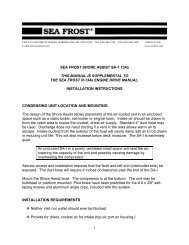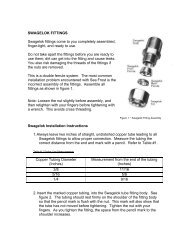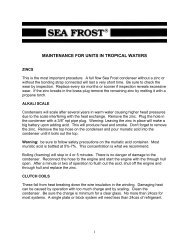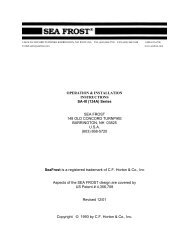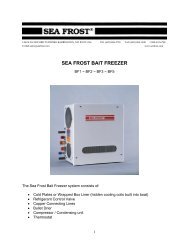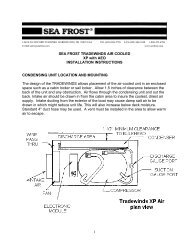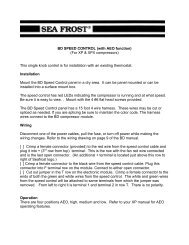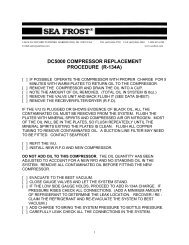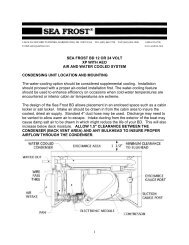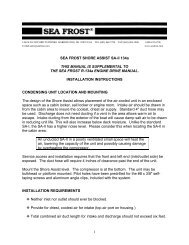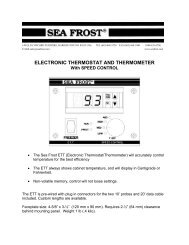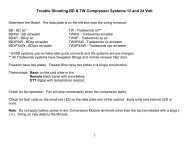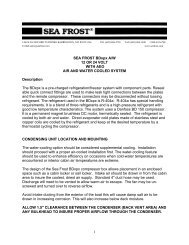BG 1000 (134a) 110V - Sea Frost Refrigeration
BG 1000 (134a) 110V - Sea Frost Refrigeration
BG 1000 (134a) 110V - Sea Frost Refrigeration
You also want an ePaper? Increase the reach of your titles
YUMPU automatically turns print PDFs into web optimized ePapers that Google loves.
148 OLD CONCORD TURNPIKE BARRINGTON, NH 03825 USA TEL (603) 868-5720 FAX (603) 868-1040 1-800-435-6708<br />
E-Mail:sales@seafrost.com<br />
www.seafrost.com<br />
OPERATION & INSTALLATION<br />
INSTRUCTIONS<br />
<strong>BG</strong> <strong>1000</strong>-B COBRA<br />
134A SERIES<br />
C.F. HORTON & CO., INC.<br />
148 OLD CONCORD TURNPIKE<br />
BARRINGTON NH 03825<br />
U.S.A.<br />
(603) 868-5720<br />
SEA FROST is a registered trade mark of C.F. Horton & Co., Inc.<br />
Aspects of the SEA FROST design are covered by<br />
US Patent # 4,356,708<br />
Revised 2001<br />
Copyright © 1992 by C.F. Horton & Co., Inc.<br />
1
TABLE OF CONTENTS<br />
<strong>BG</strong> <strong>1000</strong> OPERATION 4<br />
ICE MAKING 5<br />
MAINTENANCE 6<br />
HOW REFRIGERATION WORKS 8-9<br />
INSTALLATION 10<br />
SWAGELOK FITTINGS 11-13<br />
INSTALLATION INSTRUCTIONS 14<br />
VALVE UNIT 15<br />
THERMOSTAT 17<br />
SAFETY 18<br />
GAUGES 20<br />
LEAK CHECKING 23-24<br />
NEW SYSTEM CHARGING 25-26<br />
CHECKING THE CHARGE / ADDING CHARGE 27-28<br />
TROUBLESHOOTING 29-31<br />
ACCESS PORT LOCATION (DWG) 33<br />
WATER CIRCUIT (DWG) 34<br />
SINGLE VALVE SERIES (DWG) 35<br />
SINGLE ZONE WIRING (DWG) 36-37<br />
SYSTEM PRESSURE CHARTS 37-39<br />
MARCH PUMP 39<br />
THERMOSTAT CALIBRATION INSTRUCTIONS 40-41<br />
NOTICE OF RESPONSIBILITY<br />
It is the SEA FROST/ C.F. Horton & Co., Inc. intent to provide the safest, most<br />
accurate and detailed instructions. SEA FROST/ C.F. Horton & Co., Inc. can not<br />
be responsible for problems or damage caused by omissions, inaccuracy or interpretations<br />
of these instructions.<br />
2
148 OLD CONCORD TURNPIKE BARRINGTON, NH 03825 USA TEL (603) 868-5720 FAX (603) 868-1040 1-800-435-6708<br />
E-Mail:sales@seafrost.com<br />
www.seafrost.com<br />
A VIEW OF THE FUTURE:<br />
As a once wonderful invention, refrigerants are now the latest enemy as our awareness<br />
of the universe increases. To the end regarding conservation we have always offered a<br />
leak proof system. We have also always designed our systems to operate with the<br />
lowest quantity of refrigerant. We are concerned.<br />
There is a global impact from all refrigerants and it is time now to address the concept<br />
of "invisible pollutants".<br />
Your new R-<strong>134a</strong> system has little environmental impact that we know of at this time.<br />
This not to say those millions of tons of refrigerant won't make some problem in the<br />
future. We must enjoy the benefits of refrigeration but be conscious of the<br />
maintenance of the machinery to avoid unnecessary leaks and waste. Everyone must<br />
be involved.<br />
Thank you for supporting our product. We are proud to be providing what we feel is the<br />
best equipment available, bar none.<br />
Cleave Horton<br />
3
<strong>BG</strong> <strong>1000</strong> OPERATION<br />
The SEA FROST <strong>BG</strong> <strong>1000</strong> system is an electrically driven refrigeration plant. Operation<br />
of the compressor will freeze the contents of the holdover plates in the boat's icebox<br />
providing refrigeration by cold holdover for an extended period after the compressor has<br />
been turned off. A boat without continuous power can benefit from this by operating the<br />
SEA FROST <strong>BG</strong> <strong>1000</strong> system when the generator plant is operated. Operation time will<br />
vary with each boat.<br />
A little time spent learning about your system and some experimentation will be best.<br />
Maximum holdover will be reached when the cabinet is at the desired temperature and<br />
the holdover plates are frozen. Running times beyond this have no advantage other<br />
than to delay warming the plates.<br />
The system is water-cooled. Water should begin to flow from the discharge at the same<br />
time the unit starts. Be sure the water is flowing. If no water flows, stop the system and<br />
inspect the water pump and strainer for obstructions. (See "Troubleshooting" and<br />
"Maintenance" sections.)<br />
After starting a warm system check the plates for a temperature drop. If a temperature<br />
drop is not indicated, stop the unit and read; "Checking The Charge", and; "Reading<br />
The Sight Glass".<br />
CONTROLS<br />
The <strong>BG</strong> <strong>1000</strong> thermostat control is labeled with off, one, two, and three snowflakes.<br />
When the boat’s breaker panel is switched on and 110-volt power is available, turning<br />
the knob from "off" to one snowflake will start the compressor. Turning the knob to<br />
three snowflakes will increase the time the compressor operates, making the<br />
temperature cooler. Experiment with the control position to obtain the best setting.<br />
4
ICE MAKING<br />
Your SEA FROST 809 holdover plate(s) may be equipped with vertical ice trays. The<br />
ice trays are held in contact with the plates by a stainless steel rod.<br />
Fill the vertical trays with water and hang them on the face of the plate. Try to get some<br />
water between the tray and the plate surface to increase the thermal contact (increasing<br />
freezing ability).<br />
HARVESTING ICE<br />
Plan to wait some time after the trays are frozen for them to thaw in a sink or away from<br />
the plate in the refrigerator. When the outside surface is wet, invert the tray and let the<br />
ice slide out.<br />
STORAGE OF ICE CUBES<br />
After ice has been made and harvested, store it in sealable plastic bags in the<br />
refrigerator or if so equipped in the freezer. Ice trays left in contact with the plate will<br />
melt rapidly if the plate goes above freezing.<br />
DEFROSTING<br />
It is important to defrost the holdover plates regularly. This will maximize the efficiency<br />
of the system and ice making performance. It is not necessary to turn off the system to<br />
defrost. Scrape off any frost with a piece of wood or galley utensil. A noticeable drop in<br />
the cabinet temperature will occur.<br />
BAG STYLE ICE MAKING<br />
If your SEA FROST system is not equipped with the vertical tray kit, you can still make<br />
ice. One method is to use ziplock bags. When filled with water a clip binder or a clamp<br />
of your own invention can hold the bag in contact with the plate.<br />
5
<strong>BG</strong> <strong>1000</strong> MAINTENANCE<br />
Like your engine, your SEA FROST needs periodic checking.<br />
ROUTINELY CHECK:<br />
1. The refrigerant charge (see "Checking The Refrigerant Charge" text NEVER<br />
OPERATE SYSTEM WITHOUT PROPER CHARGE)<br />
2. All components, all tubing, fittings, and hose clamps for corrosion and wear. BE<br />
SURE TO LOCATE AND INSPECT ALL FITTINGS AND COMPONENTS IN THE<br />
SYSTEM. KNOW THE LOCATION OF ALL CONNECTION POINTS. Spray with a<br />
petroleum rust inhibitor REGULARLY. Corrosion unchecked in the marine environment<br />
will severely reduce the life of your system.<br />
CLEANING<br />
The holdover plate’s surface protects itself with a layer of oxidation. You might find that<br />
after a long period of storage the plates will look chalky. This will not effect operation<br />
and is easily cleaned up with a pot scrubber and soap.<br />
WATER STRAINER<br />
The water pump must be protected from damage and blockage by a seawater strainer.<br />
This strainer must be inspected and cleaned routinely.<br />
ROUTINE SERVICE AND INSPECTION<br />
We recommend sea strainer inspection before leaving the boat unattended dockside<br />
with the unit on. A visual inspection may be adequate depending on the type of<br />
strainer. To clean most types of strainers, close the seacock, open the strainer, remove<br />
the screen or basket, clean, reassemble and open the seacock. Operate the system<br />
and check for water flow and leaks around the strainer opening.<br />
PUMP IMPELLER INSPECTION (if pump is inoperative)<br />
The LC3 pump is a sealed liquid cooled magnetic drive centrifugal pump. The impeller<br />
may be inspected for obstructions and wear by first closing the seacock. Drain the<br />
pump housing by removing a hose if necessary.<br />
6
It is IMPORTANT that NO WATER flows between the plastic housing and the pump<br />
body. The screws that hold the cover also seal the housing. Water behind the housing<br />
will ruin the motor bearings.<br />
BE SURE THE PUMP HOUSING IS ABSOLUTELY DRY BEFORE DISASSEMBLY.<br />
Remove the phillips screws holding the inlet fitting plate (larger hose size). The impeller<br />
may then be removed with its ceramic seal and thrust washer. Reassemble in the<br />
reverse order. (An exploded diagram is in this manual.) Observe the "O" ring that seals<br />
the housing cover plate. Make sure it is in good condition. Open the seacock. Inspect<br />
for leaks.<br />
NEVER OPERATE THE PUMP WHILE DRY. IF IT IS SUSPECTED THAT THIS<br />
CONDITION HAS OCCURRED, INSPECT THE IMPELLER AND HOUSING FOR<br />
WEAR.<br />
CHECKING THE REFRIGERANT CHARGE<br />
SIGHT GLASS LOCATION<br />
The <strong>BG</strong> <strong>1000</strong> system is fitted with a sight glass located in the top of the RFD (receiver<br />
/filter/dryer). The RFD is a round blue canister about 9 inches high and 3 inches in<br />
diameter. It is located in the left corner of the compressor housing.<br />
CHECKING THE CHARGE<br />
The charge level should be inspected to be sure refrigerant is of the proper amount and<br />
that there are no slow leaks. Switch the unit on and immediately inspect the sight glass.<br />
White foam with high velocity should be observed and after a minute or two show a<br />
black or clear condition. A clear glass and an empty glass will look the same. A<br />
transition must be seen to be sure that refrigerant is present. Do not operate a low or<br />
empty system. See; "Leak Checking and Adding Charge".<br />
LAY-UP (Winterizing)<br />
Flush the pump and condenser with plenty of fresh water. Pressure water should be<br />
flushed through the inlet side of the water pump. In freezing climates a 50/50 mix of<br />
antifreeze and water should be pumped through, after flushing, by operating the system<br />
for a very brief period. Connect a short hose to the suction side of the pump to draw<br />
from a bucket. Run the pump (switch on unit) until antifreeze is discharged. (The pump<br />
is not self-priming and may require filling the hose and pump with a funnel). DO NOT<br />
RUN THE PUMP DRY. It is water lubricated.<br />
7
HOW REFRIGERATION WORKS<br />
There are two important concepts to understand in order to learn about refrigeration.<br />
They are latent heat and phase changes.<br />
A great deal of heat is required to change a solid to a liquid, and a liquid to a gas. A<br />
great deal of heat must be removed to reverse these changes. These changes are<br />
called phase changes, or changes of state. The heat removed or added at these phase<br />
changes has no effect on the temperature of the substances until the change is<br />
complete. For instance, ice melts at 32 degrees F; water freezes at 32 degrees F also.<br />
Ice and water will remain at 32 degrees F until the freezing or melting process is<br />
complete. Latent heat is this hidden energy required to make or break the bonds in a<br />
phase change.<br />
By evaporating liquid to a vapor, we can absorb heat. By condensing a vapor to a<br />
liquid, we give up heat. <strong>Refrigeration</strong> is the use of these phase changes to move heat<br />
out of the icebox (cooling it).<br />
We all know that cold is the absence of heat. A practical example of heat absorption by<br />
evaporation is that of rubbing alcohol evaporating in your hand and cooling it. The<br />
alcohol is actually using the heat from your hand to boil. The absorption of heat cools<br />
your hand.<br />
Pressure effects the temperature at which a gas phase change will occur. Using water<br />
as an example, water boils at sea level at 212 degrees F. On top of Mt. Everest it boils<br />
at a much lower temperature. The air pressure is lower allowing the water-to-steam<br />
phase change to occur more easily. A pressure cooker increases the pressure on water<br />
to restrict boiling to a higher temperature. A pressure cooker will cook food faster<br />
because the temperature is higher. Remember that a phase change involves latent<br />
heat. The temperature of boiling water is only 212 degrees F. at sea level. The<br />
evaporation action is absorbing heat at a rate equal to the rate of heat applied,<br />
preventing further temperature rise.<br />
Let's look at Refrigerant-134-a (R-134-a). R-134-a will boil at minus 15 degrees F. at<br />
sea level. By evaporating liquid R-<strong>134a</strong> in the SEA FROST plates heat is absorbed<br />
making refrigerant vapor. To dispose of this heat, a condensing phase change is<br />
necessary. By increasing the pressure (compressing) we can raise the boiling point of<br />
the gas vapor. Heat is removed from the pressurized gas vapor at the condenser.<br />
<strong>Sea</strong>water passing the condenser coils removes the heat, forcing the vapor to a liquid<br />
state again. Pressure, therefore, is the key that allows passing the heat we have taken<br />
from the icebox to a warmer place (the seawater) and converting the gas to a liquid to<br />
be re-evaporated again.<br />
8
By causing R-<strong>134a</strong> to boil (evaporate) in the SEA FROST plates, we absorb the heat<br />
energy there. This activity cools the liquid solution within the plates, causing it to<br />
change phase (freezing to a solid). By freezing this solution, we have increased its heat<br />
absorption capacity more than 100 times.<br />
When the cycle is stopped (compressor is turned off) the plates will begin to absorb the<br />
heat that leaks through the insulation in the icebox. The absorption will be at a constant<br />
temperature until the phase change to liquid (melting) is complete. This is the principle<br />
of holdover refrigeration and the function of your SEA FROST.<br />
9
INSTALLATION<br />
Installer's care should be stressed. No matter how good SEA FROST equipment is, its<br />
performance and life are in the hands of the installer. To insure your work:<br />
1. Read this manual.<br />
2. Reread any aspect your don't understand.<br />
3. Follow Swagelok fitting instructions carefully.<br />
4. Spend enough time leak checking to be sure there are no leaks.<br />
5. Thanks from all of us who have to guarantee your work.<br />
There are two contaminants that will give you problems in any refrigeration system.<br />
They are WATER and DIRT. Moisture is always present and cannot be eliminated,<br />
water in this case refers to puddles and drops. Dirt is any solid. The installer's habits<br />
will be most important in ensuring a trouble-free start-up. We have added a large<br />
receiver filter dryer (RFD) to take care of all dirt and moisture that might get into the<br />
system during a careful installation. Moisture in the system is boiled off when the<br />
system is evacuated, or it is captured in the desiccant. There is a screen in the<br />
expansion valve to prevent dirt from plugging it.<br />
Excess moisture that the RFD can't handle will plug the expansion valve with ice. This<br />
ice stops the cycle. The only cure is to discharge the refrigerant, replace the RFD, reevacuate<br />
the system, and recharge it. This remedy takes time and is somewhat costly.<br />
Keep the system clean when installing it to save time for something more fun.<br />
TUBE HANDLING<br />
Installation is quite simple. All the copper tube comes to you with the ends capped.<br />
Any routing of the tube must be done with the tube either taped or capped. Cap both<br />
tube ends after each cut. (Spare caps have been included). Work with only one line at<br />
a time, and only uncap one end at a time.<br />
TUBE CUTTING<br />
Use only a tube cutter; hacksawing or any other method will introduce chips to the<br />
system and also distort the tube, making connections difficult and leak-prone. A<br />
miniature cutter is essential for this work. CUT SLOWLY to avoid a ridge on the inside<br />
of the tube. We do not recommend reaming or dressing the cut, as it is very easy to get<br />
chips of copper in the system, which may cause trouble.<br />
TUBE BENDING<br />
Make all but the long sweep bends with a spring bender; one kink and the line must be<br />
rerun. Don't add any more fittings than are absolutely necessary. Route all lines in<br />
such a way that they are most direct but out of the way. Again, keep everything sealed<br />
until you are ready to make that connection.<br />
10
NOTES ON SWAGELOK FITTINGS<br />
Swagelok fittings come to you completely assembled, finger-tight. (Pieces a, b, and c in<br />
Drawing #1 are already together). They are ready for immediate use.<br />
Disassembly before use can result in dirt and foreign material getting into the fitting and<br />
causing leaks. If disassembly is necessary, reassemble per Drawing # 1.<br />
This is a double ferrule system. The most serious installation problem encountered with<br />
SEA FROST is the incorrect assembly of these fittings. Be absolutely sure that you<br />
assemble all fittings as in Drawing #1.<br />
To ease assembly slacken the fitting nut slightly before pushing onto the tube, then<br />
retighten with fingers before tightening with a wrench. (This is to avoid cross threading.)<br />
Step 1. Always leave two inches of straight, undistorted tubing leading to all Swagelok<br />
fittings to allow a proper connection.<br />
Step 2. Prior to inserting 1/2" tubing into Swagelok tube fitting, make a pencil mark one<br />
inch from the end of the tube. Prior to inserting 3/8" tubing, make a pencil mark 3/4"<br />
from the end of the tube. With 1/4" tubing make the mark 5/8" from the end.<br />
Step 3. Insert clean, smooth tubing with the pencil mark into the Swagelok tube fitting.<br />
You can be sure the tube is resting firmly on the shoulder of the fitting when the pencil<br />
mark is flush with the nut.<br />
Step 4. Tighten the Swagelok nut to a wrench snug* position. Scribe the nut with a<br />
pencil at the 6:00 o'clock position. (See drawing #1 step # 2.)<br />
* Wrench snug is the first point in the assembly tightening when the tube can not be<br />
pulled from the fitting, (i.e. when the ferrules tighten enough to contact the tubing).<br />
Step 5. Now, while holding the fitting body with a back-up wrench, tighten the nut oneand-one-quarter<br />
turns (1-1/4). To do so, watch the scribe mark, make one complete<br />
revolution, and continue to the 9:00 o'clock position. (See drawing # 1, step #3.)<br />
11
DRAWING 1<br />
STEP 1<br />
Simply insert the tubing into the<br />
SWAGELOK tube fitting. Make sure that<br />
the tubing rest firmly on the shoulder of<br />
the fitting and that the nut is wrench<br />
snug.<br />
STEP 2<br />
Before tightening the SWAGELOK nut,<br />
scribe the nut at the six o'clock position.<br />
12
STEP 3<br />
Now, while holding the fitting body steady<br />
with a backup wrench, tighten the nut 1 1/4<br />
turns. Watch the scribe mark, make one<br />
complete revolution and continue to the 9<br />
o'clock position. By scribing the nut at the<br />
6 o'clock position as it appears to you,<br />
there will be no doubt as to the starting<br />
position. When tightened 1 1/4 turns to<br />
the 9 o'clock position you can easily see<br />
that the fitting has been properly installed.<br />
* SWAGELOK FITTINGS ARE TO BE TIGHTENED TO A TORQUE SPEC, NOT<br />
INFINITE TIGHTNESS. BE SURE YOUR STARTING POINT IS WRENCH SNUG.<br />
(SEE STEP 4 on page 10.) A DISTORTED TUBE MIGHT GIVE A FALSE STARTING<br />
POINT.<br />
* Swagelok fittings have a built-in spring interaction between the ferrules. This<br />
compensates for temperature changes and allows the fittings to be reconnected many<br />
times. As the fitting is tightened, a burnishing occurs between the body of the fitting and<br />
the ferrules and between the ferrules and the tube. This action provides the tightest<br />
connection available.<br />
* When making all connections, USE TWO WRENCHES. Don't allow the fittings to turn<br />
or twist when tightening.<br />
RECONNECTING PRE-SWAGED FITTINGS<br />
Connections can be disconnected and retightened many times.<br />
When reconnecting, insert the tubing with pre-swaged ferrules into the fitting until the<br />
front ferrule seats in the fitting. Tighten the nut by hand to prevent cross threading.<br />
Tighten the nut one-quarter of a turn with a wrench (or to original one-and-one-quarter<br />
tight position). Then snug slightly with the wrench. No more than an additional 1/8 turn.<br />
13
INSTALLATION<br />
CONDENSING UNIT LOCATION AND MOUNTING<br />
The design of the <strong>BG</strong> <strong>1000</strong> allows placement of the unit in an enclosed space such as a<br />
cabin locker, sail locker or engine area.<br />
The <strong>BG</strong> <strong>1000</strong> is a high powered unit. It produces some noise and vibration. Its duty<br />
cycle will be short however, consider that dockside operation may be noticed when the<br />
generator is not masking the sound. Bulkhead mounting is fine, but avoid mounting on<br />
a bulkhead that may resonate into the cabin area. If an under bunk installation is used,<br />
turning off the thermostat at night will avoid a startling sound should the unit start.<br />
SERVICE ACCESS<br />
Service access and installation require that the front and left end (water fitting end) be<br />
accessible.<br />
RECEIVER FILTER DRYER (RFD) VISIBILITY<br />
LOCATION: The RFD is in the left corner of the compressor unit. Be sure that it can be<br />
viewed from the top. A mirror might be mounted above the glass to allow ease of<br />
inspection if the unit is to be mounted close to an overhang or under a deck.<br />
MOUNTING<br />
Mount the <strong>BG</strong> <strong>1000</strong> level. The unit may be bulkhead or platform mounted. It may be<br />
hung from its case. Use the aluminum ell brackets supplied. The 1/4-20 X 1-3/4<br />
Stainless screws thread into the Well-nut mounts at the back corners of the housing.<br />
Mount holes for standard fasteners are also drilled in the forward edge of the bottom of<br />
the cabinet.<br />
PLATES<br />
SEA FROST holdover plates mount with a<br />
"Wellnut" expandable neoprene blind hole<br />
fastener. A template or the part itself<br />
should be used to locate the mounting<br />
holes. Drill 1/4" pilot holes then increase<br />
them to 1/2". Install the screw into the<br />
mounting tab then screw the mount onto<br />
the screw. Install the plate pushing the<br />
rubber mounts Into the predrilled holes.<br />
Tighten the screws firmly.<br />
14
VALVE UNIT<br />
For appearance and convenience of installation, the valve unit (V/U) may mount outside<br />
the icebox. The valve will attract moisture and drip if it is not well insulated with the<br />
valve blanket and additional insulation. Insulate the valve after installation and leak<br />
checking. In certain applications it may be necessary and easier to mount the valve<br />
inside the cabinet. Refer to schematic drawings when connecting more than one plate.<br />
Before cutting the tubing:<br />
1. Leave a minimum of one inch of tube beyond a bulkhead.<br />
2. Allow room for wrench access.<br />
- 90-degree elbows can be installed on the valve unit to reduce space requirements if<br />
necessary.<br />
- The tubing will support the valve unit.<br />
- The tubing must bottom in the fitting. Refer to the Swagelok assembly instructions.<br />
RUNNING THE TUBING<br />
Make the connection to the compressor and RFD after all other connections are<br />
made. A 1/4" copper tube runs between the compressor unit and the valve. Multiple<br />
plate hook-ups should be assembled as indicated by the specific diagram provided.<br />
A 1/2" line connects the valve unit to the compressor.<br />
If possible run the 1/4" liquid line in contact with the 1/2” line. This will be insulated in<br />
proper sequence. Support the tubing (every 12 to 18 inches) as necessary with tie<br />
wraps. After leak checking and, insulating.<br />
WARNING: READ SAFETY SECTION BEFORE PROCEEDING<br />
15
FINAL ASSEMBLY<br />
The RFD contains desiccant to absorb moisture and the compressor oil is hydroscopic<br />
therefore it is important to open the compressor and RFD fittings after all other<br />
connections are made and the system is ready to be commissioned.<br />
The <strong>BG</strong> <strong>1000</strong> unit is shipped under some nitrogen pressure. Before removing the caps<br />
on the connection ports remove the screw caps on the service valves and depress the<br />
cores with a clean retracted pen point to vent any existing pressure.<br />
After depressurizing, working with one connection at a time, remove the Swagelok caps<br />
from compressor and liquid line. Attach in the proper assembly sequence the front and<br />
back ferrules and the Swagelok nuts. (Refer to the Swagelok instructions on page 11.)<br />
RFD (Receiver Filter Drier)<br />
The RFD contains desiccant to absorb moisture and<br />
the absorption is limited. Leaving the RFD installed<br />
on a partially open system may reduce its capacity<br />
by allowing it to absorb moisture in free air before the<br />
system is sealed. See "Work Habits."<br />
The RFD is a reservoir for excess refrigerant. The<br />
RFD also contains a sight glass in the top. A pick-up<br />
tube extends from the bottom of the canister to the<br />
outlet.<br />
16
THERMOSTAT<br />
For the best looking job the thermostat should be cut into a panel. We do not<br />
recommend installation in the insulation or in the box, as the control is not moisture<br />
protected. A cutting template is provided. Locate the thermostat close enough for the<br />
"bulb" tube to reach. It is only necessary that the bulb end of the sensing tube be<br />
installed on the plates. Use one of the mount screws for attaching the stainless clip on<br />
the plates. The sensing tube is hollow and filled with refrigerant; avoid bending it, which<br />
could cause it to crack and leak. Secure any excess capillary tube in a coil inside the<br />
refrigerated cabinet. Do not allow the capillary tube to contact any of the copper tubes.<br />
THERMOSTAT WIRING<br />
The thermostat electrical leads are low voltage for safety. Connect the red thermostat<br />
wires to the two terminal screws on the <strong>BG</strong> <strong>1000</strong>. Use the # 10 ring terminals provided.<br />
110-VOLT CIRCUIT<br />
A separate 20-amp breaker is required for the 110-volt circuit. Line voltage connects to<br />
the “power in” section of the terminal strip located behind the panel cover. (See page<br />
37.) Secure all wiring as necessary. We recommend following ABYC guidelines for<br />
wire specifications and proper procedures.<br />
PUMP INSTALLATION<br />
Proper pump installation is important for pump operation. The <strong>BG</strong> <strong>1000</strong> uses a<br />
centrifugal pump, which is not self-priming. Air pockets caused by loops or descending<br />
lines from one component to the other may cause pump problems. The pump is water<br />
cooled and lubricated. It must never be run dry; doing so will destroy the wet end if it is<br />
started or run dry. A separate through hull fitting 3/4" or larger should be used. It<br />
should be as low in the boat as possible and away from head and cockpit drains. A<br />
forward facing scoop will prevent problems if the unit is operating underway.<br />
A large seawater strainer should be mounted above the seacock.<br />
The pump should be mounted horizontally and higher than the strainer. The discharge<br />
should be on the top.<br />
Refer to the pump drawing at the back of this manual.<br />
WIRING THE PUMP<br />
The pump is connected to the “water pump” section of the terminal strip.<br />
17
REFRIGERANT HANDLING AND SAFETY<br />
Do not proceed with any aspect of a procedure if you do not fully understand the<br />
procedure and know what to expect in results from it. Understand fully that pressure<br />
exists in refrigeration systems. Be careful.<br />
REFRIGERANT<br />
SEA FROST is charged with REFRIGERANT-<strong>134a</strong>. R-<strong>134a</strong> is a chemical compound<br />
called tetrafloroethane and is almost odorless. Its boiling point is -15. Degrees F. at sea<br />
level. It is heavier than air. It's label and container color is cloud blue.<br />
GENERAL SAFETY THIS IS IMPORTANT. READ THIS!<br />
R-<strong>134a</strong> is safe if handled properly. Avoid breathing vapors and prolonged skin<br />
exposure. Avoid using in areas of open flames. The vapor is heavier than air and may<br />
reduce oxygen available for breathing. Use with sufficient ventilation to keep exposure<br />
below recommended limits. Do not mix with air for leak testing or use with air for<br />
any purpose above atmospheric pressure. Liquid R-<strong>134a</strong> will freeze skin. It's<br />
especially dangerous to the irreparable tissues of the eyes.<br />
--WEAR EYE PROTECTION--<br />
YOU WOULD BE A LOUSY BLIND MUSICIAN.<br />
Do not pressurize an empty system with R-<strong>134a</strong> without first evacuating the<br />
system with a vacuum pump.<br />
WARNING: DANGER! NEVER OPERATE A SYSTEM WITH THE HIGH SIDE<br />
(DISCHARGE) OPEN TO THE REFRIGERANT SUPPLY. PRESSURIZATION OF THE<br />
REFRIGERANT SUPPLY COULD CAUSE IT TO BURST.<br />
18
PROCEDURES FOR WORKING WITH R-<strong>134a</strong><br />
1) A new uncharged system must be evacuated before adding R-<strong>134a</strong>.<br />
2) An R-<strong>134a</strong> system must only be pressurized with R-<strong>134a</strong> or nitrogen.<br />
3) Only service tools dedicated to R-<strong>134a</strong> are to be used. No parts, tubing, fittings,<br />
receivers, dryers, service gauges, or any refrigerant carrying components may be fitted<br />
to a R-<strong>134a</strong> system from a used system or from a CFC based system. Damage caused<br />
by the use of parts not supplied by <strong>Sea</strong> <strong>Frost</strong> for a R-<strong>134a</strong> system will cancel all claims<br />
against <strong>Sea</strong> <strong>Frost</strong>.<br />
4) No oil is to be added to the <strong>BG</strong> <strong>1000</strong> system but the polyoester oil supplied by <strong>Sea</strong><br />
<strong>Frost</strong>, labeled and capped for <strong>BG</strong> <strong>1000</strong> use. No oil is to be added to a system with out<br />
prior consultation with <strong>Sea</strong> <strong>Frost</strong>.<br />
5) The oils used in R-<strong>134a</strong> systems are extremely moisture sensitive (hydroscopic). Do<br />
not leave any tube end or component connection open to air while assembling the<br />
system. Be sure to use only new capped copper tubing and be sure to cap the copper<br />
coil after cutting it.<br />
ACCESS TO THE SYSTEM: SERVICE PORTS<br />
The service ports are two small-capped valves. The low-pressure valve is mounted on<br />
the compressor. The high pressure is mounted on an upper tube behind the RFD. (See<br />
drawing pg. 33) The ports are different sizes. The smaller fitting is the suction port. The<br />
larger port is the discharge. These ports are the service access to the system and are<br />
covered with plastic caps to seal the system. Without the caps the valves may leak. To<br />
access these valves the proper R-<strong>134a</strong> service valve must be used.<br />
Be sure the caps are installed tightly after charging or service.<br />
NOTE: THIS SYSTEM IS CHARGED WITH R-<strong>134a</strong>. IT MUST BE CHARGED WITH<br />
R-<strong>134a</strong> ONLY. ONLY DEDICATED R-<strong>134a</strong> GAUGES AND EQUIPMENT ARE TO BE<br />
USED. ANY CONTAMINATION FROM CFC BASED REFRIGERANTS WILL<br />
DESTROY THIS SYSTEM.<br />
19
GAUGES<br />
Must be used in the evacuation and charging. They will provide information on the<br />
operation of the system when troubleshooting.<br />
A gauge sets consist of two gauges installed in a manifold with two valves and hoses to<br />
connect the gauges to the system. The left gauge (blue) is a compound device; it<br />
indicates pressure and also vacuum. The right gauge (red) indicates pressure only.<br />
The valves open a center port (yellow) to the left or right side respectively. Operation of<br />
the valves is only necessary when moving refrigerant or evacuating. With the valves<br />
closed, the gauges read the pressures of the connection points. At the end of the red<br />
and blue service hoses are R-<strong>134a</strong> service port access fittings.<br />
R-<strong>134a</strong> SERVICE PORT ACCESS FITTINGS<br />
The R-<strong>134a</strong> service port access fittings on the gauge hose ends are quick connect<br />
fittings with a specially designed valve that opens the hose end valve while opening the<br />
system service port valve.<br />
20
CONNECTING GAUGES<br />
To connect these fittings to the system service ports; remove the protective sealing<br />
caps on the service port. (See, "Access to the System”) Note that the ports are of<br />
different sizes. The larger diameter port is the discharge side and the smaller port is the<br />
suction side. Pull back the collar on the access-fitting valve and push it over the<br />
appropriate system access port. Turn the access-fitting valve clockwise to open the<br />
valves. When you see the manifold gauge pressure change, you have access to the<br />
system. Continuing to turn the access fitting valve clockwise may damage the service<br />
port. During the service operation these valves are left open. Control of refrigerant and<br />
vacuum is by the manifold hand wheels.<br />
VENTING THE GAUGE SET TO ATTACH TO A CHARGED SYSTEM<br />
If the gauge set is not fitted with sealing valves or has not been purged with refrigerant,<br />
vent the hoses for a few seconds by slacking the connections at the manifold body after<br />
connecting to a charged system. This will prevent air from entering the system through<br />
the suction port.<br />
DISCONNECTING GAUGES<br />
Disconnecting the gauge set after running the system may be done by turning off<br />
the discharge service port access fitting first. Disconnect the discharge service valve<br />
and re-cap the port. With the center port on the gauge set turned off at the refrigerant<br />
supply both hand wheels on the gauge set may be opened and the compressor<br />
operated to extract the refrigerant from the gauges. When the pressure in both gauges<br />
drops to the low side operating pressure turn off the gauge valves and the suction<br />
service valve. Turn off the compressor. Remove the suction service valve and re-cap<br />
the service port. (This procedure will remove excess refrigerant from the gauges<br />
preventing an excessive discharge of refrigerant on the next job.)<br />
Disconnecting the gauge set on a static system may be done by turning off the<br />
service valves and disconnecting them from the service ports on the service port block.<br />
Re-cap the service ports.<br />
Refer to the gauge drawing on page 20.<br />
21
Adding charge to a working system should be done through the suction side (blue)<br />
as vapor. (See; "Safety") The center hose is connected to the can tap. Be sure to vent<br />
the hoses to displace any air that might be in them (see venting the charge hose). Keep<br />
your gauges clean. Inspect the rubber gaskets and "O" rings on the hose ends, leakcheck<br />
gauge valve packing and all hose connections.<br />
Check and reset the "O" on the low side gauge, if necessary.<br />
VENTING THE CHARGE HOSE<br />
WHEN ATTACHING GAUGES TO A CHARGED SYSTEM<br />
Note: This procedure will vary with the type of gauges being used. This section will not<br />
apply to gauges fitted with valves in the hose ends.<br />
To avoid pulling air or other contaminants into the system, it is necessary to vent the air<br />
out of the hoses that are used to carry R-<strong>134a</strong> into the system. To vent the hose, open<br />
the can tap valve with the can upright (vapor) then open the service valve to allow the<br />
some vapor to escape. Make the connection as this vapor is escaping. Follow this<br />
procedure when adding refrigerant to an evacuated system or to a system low on<br />
refrigerant.<br />
TAPPING A CAN OF REFRIGERANT<br />
Be sure the can of R-<strong>134a</strong> is clean and dry. Any contaminants on the top of the can or<br />
in the hose will enter the system. First, screw the tap assembly on the top of the can.<br />
Next, screw the valve wheel into the valve body, closing the valve. (The metal point will<br />
protrude from the gasket, but it will make its own seal while piercing the can. Be certain<br />
that the gasket is present and is smooth and elastic.) Now, with the can upright, screw<br />
the valve body assembly into the clamp on the can, turning until the point pierces the<br />
can and the rubber gasket has sealed. The can is now tapped.<br />
LIQUID OR VAPOR<br />
REFRIGERANT IS EITHER a vapor or liquid. To supply vapor to a system, keep the<br />
refrigerant can in the upright position. To supply liquid to the system, invert the can,<br />
valve down. Be sure the can is handled carefully to ensure the correct refrigerant<br />
condition is supplied.<br />
CHANGING CANS<br />
The compressor should be turned off while changing cans. Close the valve on the<br />
empty can. Unscrew the can from the valve body. Some pressure may be present. Let<br />
this drop before completely removing the can tap. Switch the tap to the other can, and<br />
rethread onto the can.<br />
22
COMMISSIONING PROCEDURE<br />
EVACUATION WITH A VACUUM PUMP<br />
Evacuation removes air, readying the system for charging.<br />
Connect a gauge set to the service ports.<br />
Connect the gauge center hose to a high vacuum pump. Start the pump and slowly<br />
open the low side/suction gauge hand wheel. As the vacuum drops below 20 inches<br />
open both hand wheels fully.<br />
EVACUATION LEAK TEST<br />
Evacuate the system to the best vacuum (lowest pressure). As the gauge reaches this<br />
low pressure close the valves to the pump. Observe the vacuum gauge and be sure the<br />
pressure remains constant for 5 minutes. If the pressure rises rapidly check all the<br />
connections again. Re evacuate to the lowest pressure and test by holding a vacuum<br />
with the gauges closed. Be sure the system will hold this vacuum. Proceed by<br />
opening the valves and continuing the evacuation process for 30 minutes or more. A<br />
micron gauge can be used to measure vacuum. Proper dehydration and evacuation<br />
should be in the range of 200 to 500 microns.<br />
NEW SYSTEM CHARGING<br />
INTRODUCING INITIAL CHARGE<br />
After the evacuation leak test and pump down, shut off the manifold valves, disconnect<br />
the center hose from the pump, and connect it to a can of refrigerant. Vent the hose<br />
from can tap (refrigerant supply) to the manifold. With the refrigerant can in the inverted<br />
(liquid) position, open the discharge side valve (high side) valve and feed in about 1/2 of<br />
a can of refrigerant (6 to 8 ounces). Close the valve and begin an inspection and leak<br />
check of all the connections in the system.<br />
LEAK CHECKING<br />
Leak checking is a very important step, which should be done with diligence. A leak will<br />
cripple this system. Please take the time needed to be sure all connections are tight.<br />
Check every connection even the ones that were pre-made in manufacture.<br />
The evacuation leak check is a preliminary check and is not to be considered a system<br />
leak check.<br />
23
LEAK CHECKING A CHARGED SYSTEM<br />
ABOUT PRESSURES<br />
Refrigerant in a saturated condition, i.e. part liquid and part vapor, will exert a pressure<br />
that is a function of its temperature. The higher the temperature, the higher the<br />
pressure. Avoid leak checking in cold weather or on a cold system.<br />
A refrigerant leak will show with moderate pressure. (A leak is not a function of<br />
pressure. Pressure is only required to aid in detection).<br />
In cold weather, it is possible to raise the pressure in the system by warming the plate<br />
with a light bulb left in close proximity to the plate for several hours.<br />
There are two ways to leak-check a pressurized system:<br />
1. Soap bubbles (a solution of dish soap and water works well).<br />
2. An R- <strong>134a</strong> electronic leak detector probe, which senses the presence of<br />
refrigerant molecules.<br />
TO CHECK WITH BUBBLES<br />
Soap each connection and observe all sides of the connection with a strong light and a<br />
mirror. A leak will blow bubbles. Without careful examination and plenty of pressure<br />
this test is not reliable.<br />
TO CHECK WITH AN ELECTRONIC DETECTOR<br />
Use a detector designed for R- 134-A. Slowly trace the area with the probe.<br />
Refrigerant is heavier than air, therefore, trace below the fitting. Most units can be<br />
calibrated to home in, on a leak. (See detector instructions). (We use and recommend<br />
electronic detection. TIF brand detectors can accurately detect leaks as low as 1/2-oz<br />
loss per year. This sensitivity exceeds S.A.E. leak specifications.) Be sure to test the<br />
operation of the detector before and after you leak check the system<br />
IF A LEAK IS DETECTED<br />
Try tightening the fitting nut slightly more. (See Swagelok fitting instructions) If the leak<br />
is not stopped, it is possible that the fitting was incorrectly assembled. Reclaim the<br />
refrigerant and then disassemble the connection for inspection. After reassembly,<br />
proceed with the evacuation leak check procedure.<br />
24
SPECIAL NOTES<br />
- Be aware that propellants and solvents in sprays and foams may upset electronic<br />
detectors.<br />
- To confirm a leak detected with a detector use bubbles and be sure it is a leak and not<br />
some erroneous vapor that is upsetting the machine.<br />
- Electronic detectors do not function below 40.F.<br />
- A good leak detector is able to pick up leaks as low as 1/2 oz per year.<br />
FINAL CHARGING<br />
This procedure must follow "Evacuation Leak Test" and "Introducing Initial Charge".<br />
1. With the refrigerant supply still attached to the suction service port from the<br />
previous procedure, open the can tap valve (or appropriate gauge wheel).<br />
2. While closely observing the sight glass in the RFD, start the compressor by<br />
switching on the circuit breaker and then turning on the thermostat.<br />
3. The sight glass will show a stream of foam indicating a partial charge. When a<br />
sufficient amount of refrigerant has been added to the system (A new system<br />
holds 24 oz.) the sight glass will clear, indicating sufficient charge. (See<br />
"READING THE SIGHT GLASS”) The compressor (Thermostat) should be<br />
turned off while changing cans. When charging a hot system, (cabinet and<br />
plates over 80 degrees F) the sight glass will usually clear as the return line at<br />
the valve unit becomes frosted).<br />
4. When the sight glass runs clear, top off with approximately 4 oz. (1/4 of can).<br />
Remember maximum charge is 24 oz.<br />
5. When observation and test operation have been completed, disconnect the<br />
gauges. Replace the service port caps.<br />
6. Re-check all connection points for leaks.<br />
7. Spray the acrylic coating, or similar rust inhibitor, on all the components and<br />
fittings while they are clean and dry.<br />
25
READING THE SIGHT GLASS<br />
A clear sight glass when the compressor is operating signifies a sufficiently charged<br />
SEA FROST <strong>BG</strong> <strong>1000</strong> System. To determine the meaning of "clear", notice the<br />
appearance of the RFD sight glass when the system is at rest with the compressor off.<br />
This is a "clear" glass.<br />
SPECIAL WARNING: A clear sight glass can also indicate a completely EMPTY<br />
system. Any time the compressor is started, a white stream of foam should<br />
appear in the sight glass indicating that refrigerant is present. This foam may<br />
disappear quite quickly, but IF NO FOAM IS EVIDENT, the system is empty. DO<br />
NOT OPERATE THE SYSTEM if empty. Operation in this mode will ruin the<br />
compressor. Turn off the main breaker to prevent operation until system can be<br />
properly leak tested and recharged.<br />
A white stream of fast moving foam with the compressor operating indicates an<br />
insufficient charge level. Watch closely for a transition from foam to total liquid,<br />
indicated by a clear sight glass. This transition point can be missed if proper attention is<br />
not given. Also, IT IS POSSIBLE for the sight glass to show large bubbles even when<br />
the charge is sufficient, so it is important to differentiate between foam and bubbles.<br />
The foam condition has velocity and direction; the bubbles are large, temporary, and<br />
nearly stationary. Do not try to chase away these larger bubbles with more refrigerant,<br />
overcharging must be avoided. Air in the system may give a false sight glass reading,<br />
which could lead to overcharging. If in doubt, discharge a suspected overcharged<br />
system and charge again. MONITOR THE SIGHT GLASS CONTINUALLY. The glass<br />
will not indicate when the system is overcharged.<br />
In a warm system, when the plates are above freezing (32.F) upon start-up, the sight<br />
glass may take several minutes to clear. A cold system, in cold water, may show a<br />
clear glass within seconds of start-up.<br />
RFD SIGHT GLASS DETAIL<br />
CLEAR (OR EMPTY) STATIONARY BUBBLES FOAM<br />
26
PROPER CHARGE AMOUNT<br />
THE <strong>BG</strong> <strong>1000</strong> SYSTEM IS DESIGNED TO HOLD 24 OUNCES. THIS IS EQUAL TO 2<br />
CANS OF R-<strong>134a</strong> AS SUPPLIED WITH THE SYSTEM. THIS IS THE MAXIMUM<br />
CHARGE. The sight glass must clear by the time the return line (suction/large diameter<br />
tube) goes below 32 degrees F.<br />
GENERAL INFORMATION<br />
OPERATING PRESSURES will vary with water temperature, and water flow.<br />
Generally, the HIGH SIDE will peak with warm plates in two to four minutes. Increasing<br />
pressure indicates an overcharge or no water flow. The LOW SIDE will drop rapidly to<br />
the 20 to 10 range, and then slowly drop. The low side tubing will freeze and after<br />
extended operation the low side pressure will remain at a slight vacuum. The low side<br />
pressure will drop more rapidly when the seawater is cold. A vacuum will be indicated<br />
with less running time. A deep vacuum and proper charge with no cooling indicates that<br />
the valve unit is frozen with moisture or it is plugged. Failure to "pull down" indicates<br />
the Valve Unit is malfunctioning or flooding. See the system pressure charts on<br />
pages 37-39.<br />
The compressor will feel warm in normal operation.<br />
Every Valve Unit has been operated prior to shipment. There are no field superheat<br />
adjustments.<br />
SPECIAL NOTE<br />
WE DO NOT RECOMMEND charging SEA FROST gear with bulk cylinders since it is<br />
hard to determine how much refrigerant has been installed. The feed pressure with a<br />
bulk cylinder can be higher which may cause skipping through the condenser, causing<br />
bubbles in the sight glass. However, if bulk cylinders are used, keep the feed pressure<br />
below 20 psi.<br />
R-<strong>134a</strong> will become cloudy and indicate similar foaming in the sight glass as the<br />
pressure on the hi-pressure side of the systems becomes too great. Adding charge to<br />
clear this condition will damage the compressor. Be sure you know the pressures you<br />
should have for the corresponding water temperature.<br />
27
CHECKING THE REFRIGERANT CHARGE<br />
PERIODIC INSPECTION<br />
Checking the refrigerant charge must be incorporated into a routine maintenance<br />
schedule.<br />
1) Locate the RFD (receiver filter drier). It is a blue metal can about 10 inches high and<br />
3 inches in diameter, with brass fittings connecting it to copper tubing. The RFD has a<br />
sight glass for viewing the flow of the refrigerant. It is located in the left corner of the<br />
compressor housing.<br />
2) Start the <strong>BG</strong> <strong>1000</strong>. Check to be sure that it is pumping water.<br />
3) MONITOR THE SIGHT GLASS CONTINUALLY. See READING THE SIGHT<br />
GLASS. If the sight glass does not show a presence of refrigerant within a minute of<br />
operation the system is empty. TURN OFF THE SYSTEM, and follow the procedure in<br />
the TROUBLE SHOOTING section.<br />
4) If the white foam is evident watch closely for the transition to "clear". If the glass<br />
indicates insufficient charge level, additional charge will be needed. Turn off the<br />
compressor. Attach a can of Refrigerant-<strong>134a</strong> with a properly vented charge hose to<br />
the suction service port. Monitoring the sight glass continually, start compressor and<br />
slowly add refrigerant until the glass clears. After the glass clears add an additional 4<br />
oz of refrigerant.<br />
5) Feel the SEA FROST plates in the icebox 10 minutes after start up. If the sight glass<br />
clears yet the plate’s temperature does not drop, turn the system off and follow the<br />
procedure in TROUBLE SHOOTING.<br />
6) If the proper charge is indicated, make ice, go sailing.<br />
DISCHARGING THE SYSTEM (RECLAIMING)<br />
Before the connections or components can be disassembled, the system must be<br />
discharged. Connect a gauge set to the suction service port. (See "Access To The<br />
System" text). Slowly vent the refrigerant (keeping the pressure under 20 psi) into an<br />
approved reclaiming system. Do not loosen any connections until the gauge on the<br />
refrigeration system shows 10” vacuum for 10 minutes.<br />
28
TROUBLESHOOTING<br />
The most common problems that can occur in a SEA FROST <strong>BG</strong> <strong>1000</strong> System are:<br />
1. Overcharge or loss of water flow switching off the manual reset high-pressure<br />
switch.<br />
2. Loss of refrigerant charge resulting from leaks.<br />
3. Moisture or dirt plugging the expansion valve.<br />
4. Compressor damage due to loss of refrigerant charge.<br />
STEP 1. Gather information as to the nature of the problem before operating the<br />
system. A leak often leaves a trace of oil. Inspect the fittings and tubing for wear,<br />
corrosion, and chafe. DO NOT OPERATE THE COMPRESSOR UNTIL THE<br />
TROUBLE IS CORRECTED.<br />
HIGH PRESSURE CUTOUT/MANUAL RESET BUTTON<br />
The compressor is fitted with a MANUAL RESET high-pressure switch. The switch is<br />
located on the left end of the <strong>BG</strong> <strong>1000</strong> unit. (See drawing). This switch will disconnect<br />
the thermostat circuit switching off the compressor and water pump. Pushing the red<br />
rubber button after the unit has rested for a few minutes may reset the switch. A<br />
faint click will be heard when the button resets.<br />
BEFORE RESETTING the switch inspect the pump and strainer. Most installations<br />
have a line plug connection for the pump. If so fitted, plug the pump into a receptacle or<br />
extension cord to be sure it is operating. If the installation location of the through hull<br />
allows air to enter the system it may be necessary to bleed the air from a hose<br />
connection after the pump but below the waterline by loosening the connection. When<br />
water flows from the connection retighten the connection.<br />
*This switch will disconnect if the water flow stops.<br />
*This switch will disconnect if the system is overcharged.<br />
Overcharge may not appear until the boat moves into warmer water than it has been<br />
commissioned in. Discharge the system until the unit operates without disconnecting the<br />
high-pressure switch. Be sure that the sight glass still runs clear. For further<br />
troubleshooting, attach purged gauges at the compressor service ports.<br />
29
a) If the refrigerator box and SEA FROST plates are warm and pressure readings<br />
are below 50 psi with compressor off (in 50 degree F or higher ambient conditions),<br />
pressurize system with R-<strong>134a</strong> and leak-check. After leak (s) has been located,<br />
repaired, and tested, install new RFD (Receiver/filter/drier) - see instructions below in<br />
Step 3.<br />
b) If pressure reading is over 50 psi with compressor off, proceed to check charge<br />
level via sight glass and charge if needed.<br />
CHARGE LOSS INDICATES A LEAK THAT MUST BE CORRECTED<br />
STEP 2. If a system continues to operate inefficiently after Step 1, check for moisture<br />
or dirt plugging the valve. Run the system, observing closely the gauge readings and<br />
plates temperature, noting the following.<br />
a) If system is warm upon start-up, a DIRT-PLUGGED Valve will show an<br />
immediate deep vacuum reading on low side. Consult <strong>Sea</strong> <strong>Frost</strong> for cleaning<br />
techniques.<br />
b) MOISTURE-PLUGGED VALVE on a properly charged system is indicated by<br />
deep vacuum readings on low side after a few minutes of operation from warm,<br />
FOLLOWED BY any combination of these symptoms:<br />
-High side compressor discharge fitting temperature drops from hot to warm.<br />
-Suction line from Valve Unit remains warm.<br />
-Compressor current draw (running amperes.) drops.<br />
-Moisture enters either through a low side leak or during initial installation and will freeze<br />
at the Valve Unit, reducing or eliminating refrigeration. Turning off system and allowing<br />
the valve to warm to above freezing, then restarting, may temporarily solve the problem.<br />
If not, change RFD as follows.<br />
30
STEP 3. To change a saturated RFD, allow the system to warm to ambient<br />
temperature, thereby preventing moisture from condensing in the circuit upon opening.<br />
(A light bulb in the refrigerator box will speed the warming of the plates. RECOVER the<br />
refrigerant from system through the suction service port SLOWLY to prevent liquid and<br />
oil from escaping. WARNING: BEFORE DISASSEMBLY OF ANY PART IN THIS<br />
SYSTEM BE SURE CHARGE IS COMPLETELY RECOVERED. With a backup wrench<br />
holding the brass body of the Swagelok fittings loosen and back off the nuts. The tubing<br />
may be pulled out of the fittings. Remove the RFD. Replace only with an identical unit<br />
by size and color: THE SEA FROST RFD is a drier and also a receiver/filter. The<br />
DESICCANT and the oil in the <strong>Sea</strong> <strong>Frost</strong> RFD are special to this system and R-<br />
<strong>134a</strong>. Using the wrong oil will destroy the system.<br />
NOTE: This system contains a measured amount of lubricating oil. Be sure the RFD<br />
being installed is a cloud blue SEA FROST <strong>BG</strong> <strong>1000</strong> R-134-a RFD. Record all<br />
component exchanges in this on-board owner's manual.<br />
Follow the "re-make" instructions for Swagelok fittings.<br />
Reminder: To ensure the total removal of moisture from the system use a high vacuum<br />
pump, and evacuate the system with the highest possible plate temperature (100<br />
degrees F.). A light bulb or heat lamp in contact with the plates is a good technique.<br />
Recharge. Refer to "Recharging section"<br />
MOISTURE IS A SYMPTOM. Carefully leak check the low side of the system if<br />
moisture becomes a problem. Moisture leaks in!<br />
CALL US WITH ANY QUESTIONS<br />
TEL: 603-868-5720<br />
FAX: 603 868 1040<br />
SHIPPING AND MAIL:<br />
SEA FROST<br />
148 OLD CONCORD TURNPIKE<br />
BARRINGTON NH 03825<br />
USA<br />
31
148 OLD CONCORD TURNPIKE BARRINGTON, NH 03825 USA TEL (603) 868-5720 FAX (603) 868-1040 1-800-435-6708<br />
E-Mail:sales@seafrost.com<br />
www.seafrost.com<br />
THERMOSTAT CALIBRATION INSTRUCTIONS<br />
Note: Be sure that the unit is operating properly before making any thermostat<br />
adjustments. The sensing bulb must be in excellent thermal contact with the plate or<br />
block.<br />
The range of this control may be changed. To<br />
access the adjustment screw, remove the four<br />
mounting screws on the thermostat panel. Tip the<br />
panel forward and remove the protective tape to<br />
expose a slot in the case. Make the adjustment<br />
with a torx or small phillips head screwdriver.<br />
Make small adjustments. Record all adjustments.<br />
If the lowest setting on the thermostat panel<br />
(1-snowflake) is too cold:<br />
• Turn the adjustment screw clockwise. One<br />
360-degree turn will raise the box<br />
temperature approximately 6 degrees f.<br />
If the highest setting on the thermostat panel<br />
(3-snowflakes) is too warm:<br />
• Turn the adjustment screw<br />
counterclockwise.<br />
40
HOLDOVER PLATES<br />
STAINLESS STEEL<br />
EVAPORATOR PLATES<br />
41



